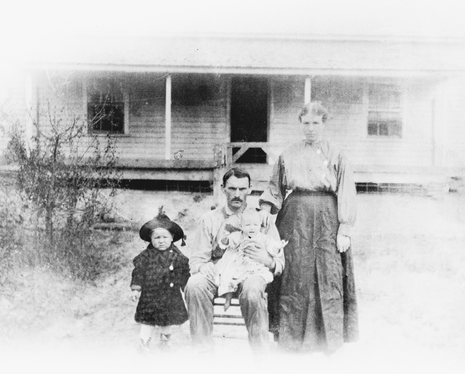
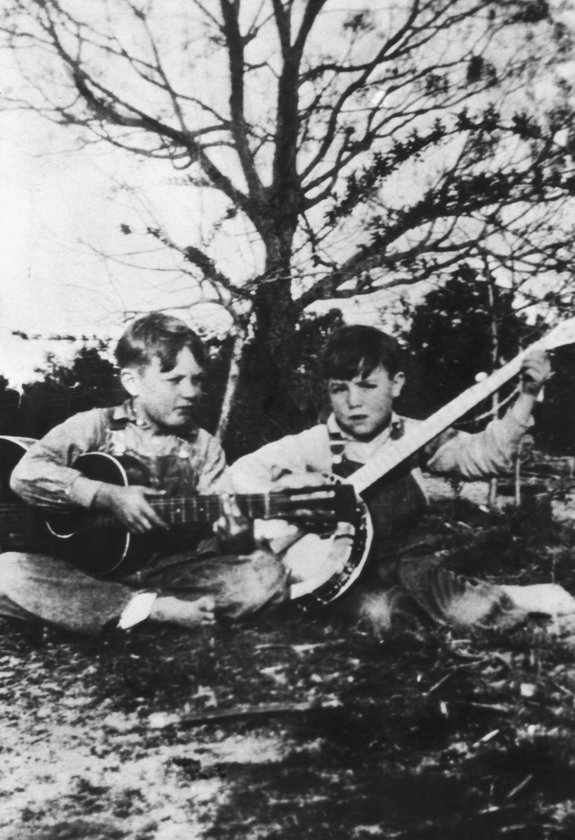


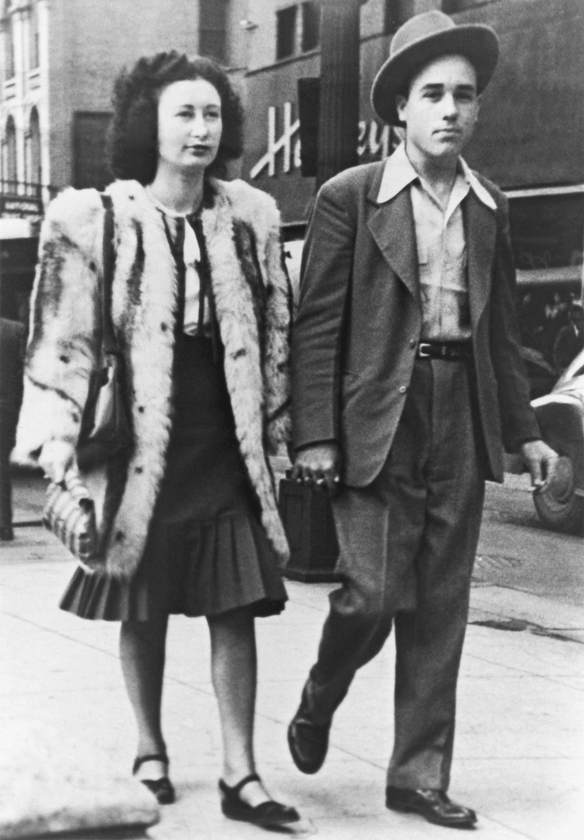
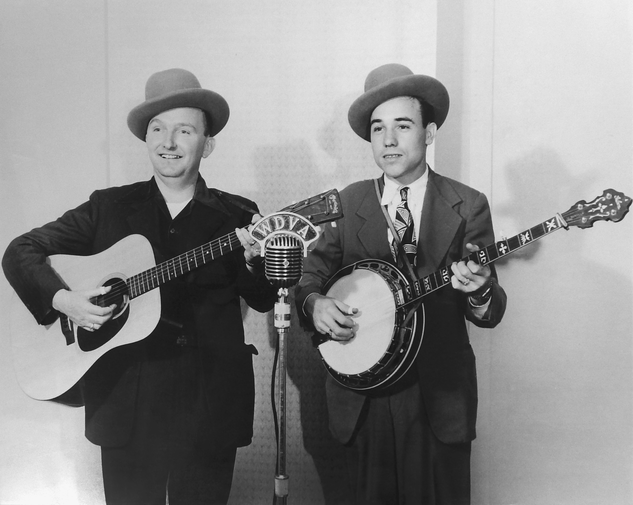

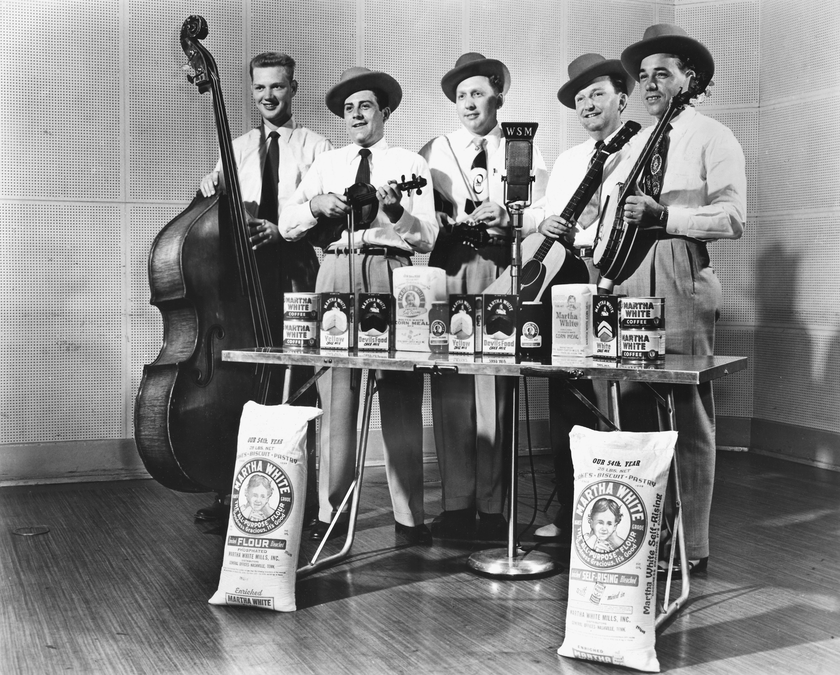

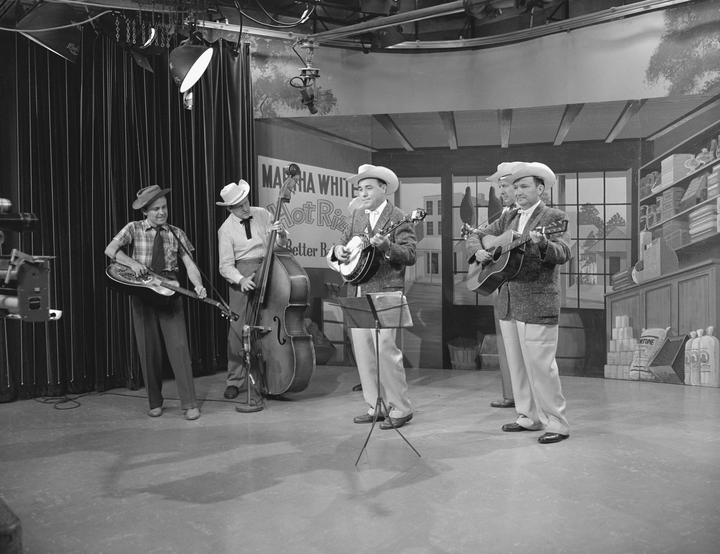
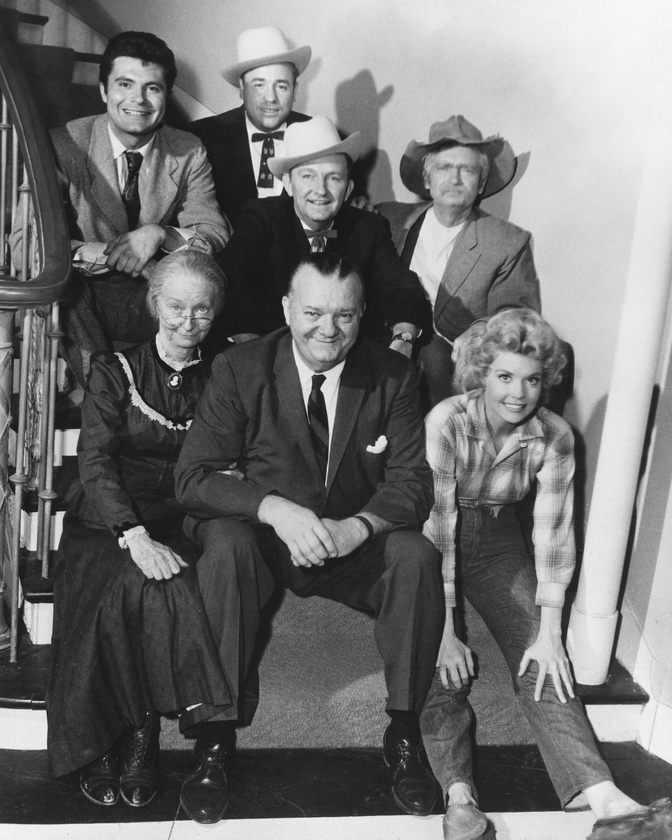
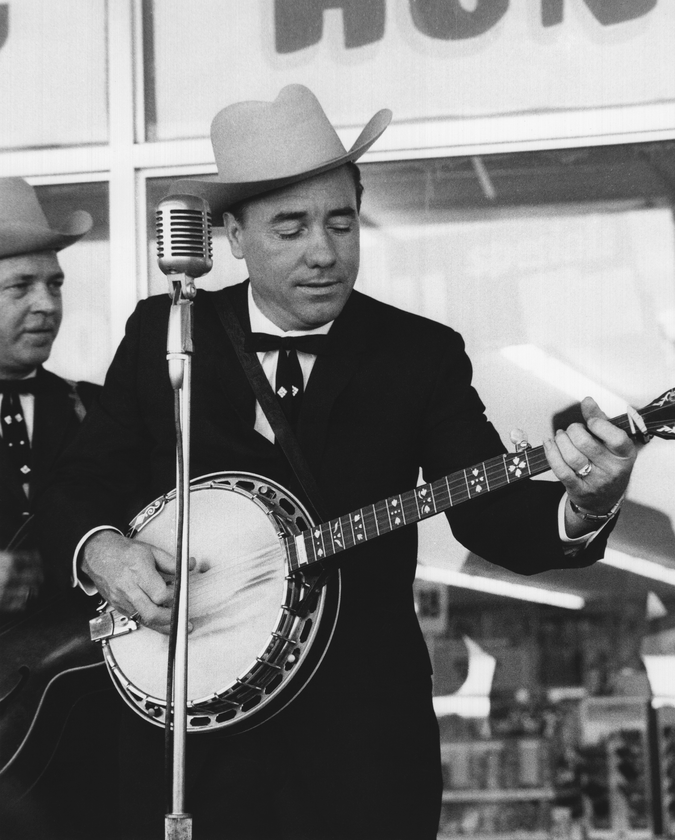


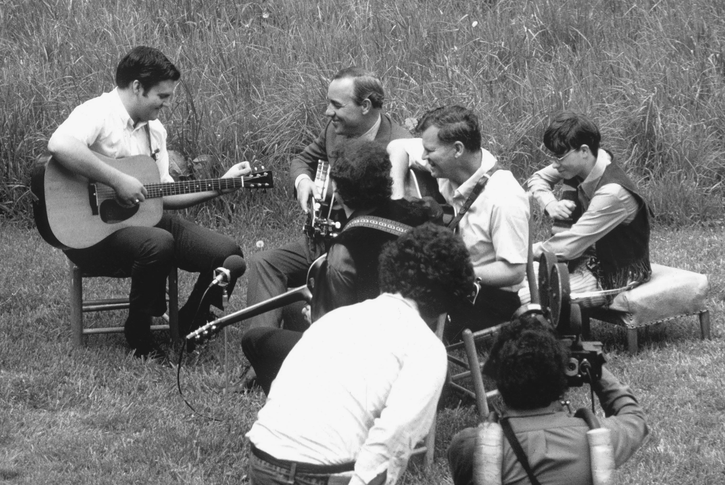
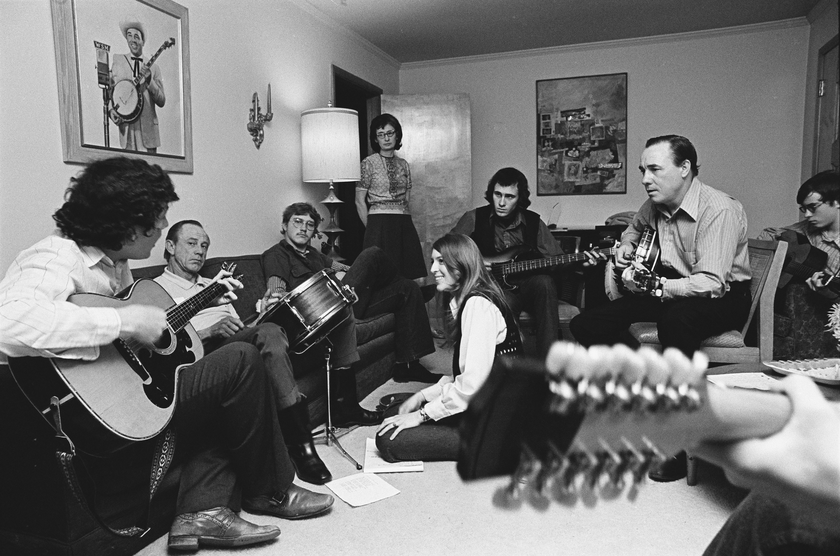
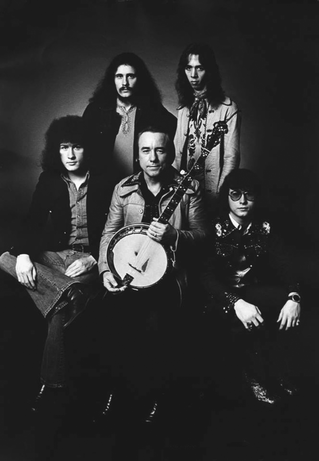
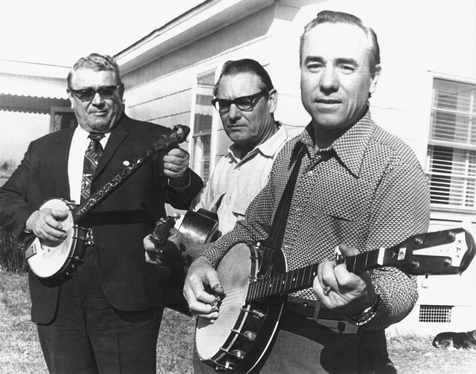
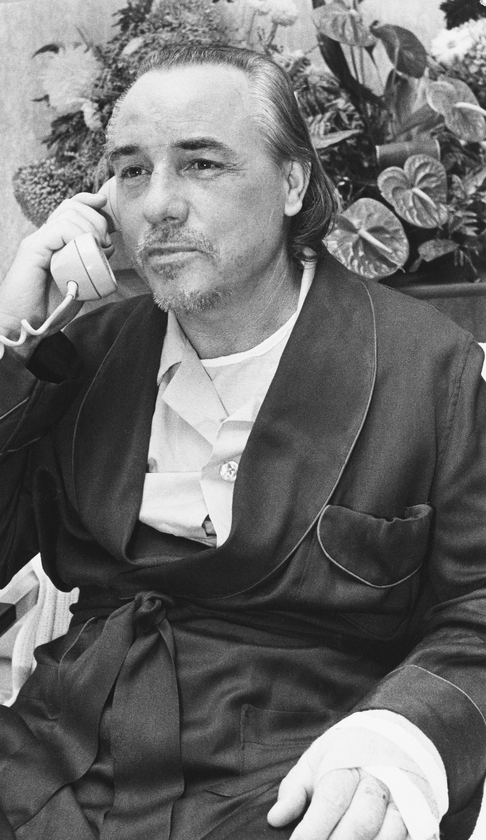

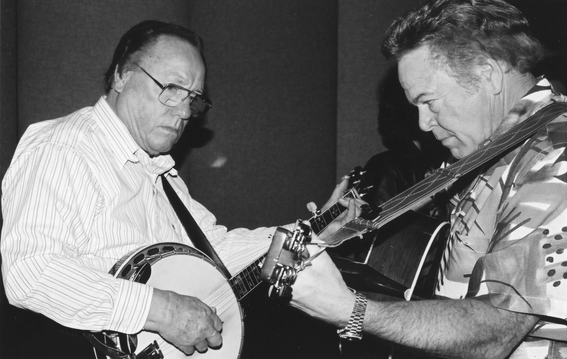
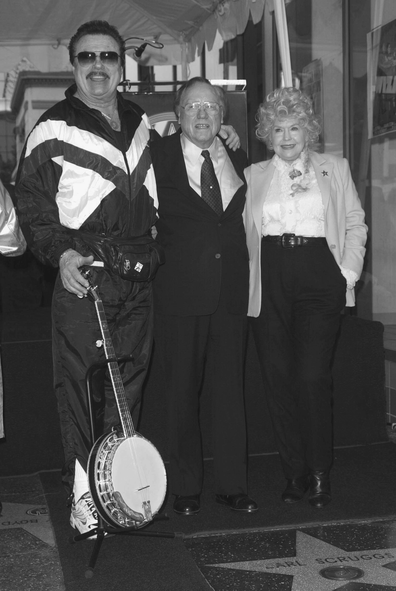

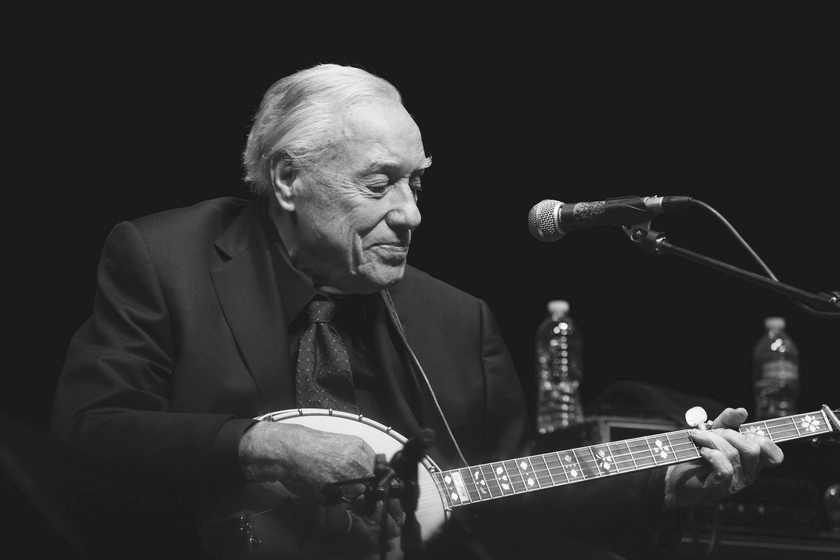

They were the only [country] band, when Elvis Presley come on the scene, [where] it didn’t hurt ’em. They still got their crowds like they always did, and that’s saying a lot. I can just hear the names Lester Flatt and Earl Scruggs and the Foggy Mountain Boys, and it just runs chills over me.
—Bobby Atkins, bluegrass banjoist
Shortly after the departure of their comedic bassist Charles “Little Jody Rainwater” Johnson in the summer of 1952, Lester Flatt and Earl Scruggs were on the cusp of receiving a major shot in the arm from one of Nashville’s biggest sponsors of the Grand Ole Opry, Martha White Mills. During their performances outside of Knoxville, Tennessee, in the fall of that year, Flatt and Scruggs, along with their current lineup of Curly Seckler on mandolin, Benny Martin on fiddle, and Bob Moore replacing Rainwater on bass, caught the attention of Efford Burke, a salesman for Martha White Mills.[1] Upon Burke’s recommendation for a possible sponsorship, Martha White’s president, Cohen T. Williams (the man who coined the company’s famous slogan “Goodness gracious, it’s good!”), decided to witness the chemistry of Flatt and Scruggs himself, as touted by professional banjo player and Scruggs historian Jim Mills:
The president of Martha White Mills, outside of Nashville, Cohen Williams, gets word that this band might be a good band to promote his flour company. He goes out and sees a show and signs them to a WSM radio job, fifteen minutes a day basically. They’re not members of the Grand Ole Opry, but they are affiliated with WSM, they get to play this show and be heard by WSM’s listeners. Well, a lot of those listeners remember them from playing with Bill Monroe to start with, and man, they have a tight band; they’ve got Benny Martin in there on the fiddle, Earl on the banjo—I mean, the best band ever. My dad even saw that band live.
In June 1953, Earl, along with a very pregnant Louise (she was two months shy of giving birth to their second son, Randy, in August) and their four-year-old son, Gary, relocated to Nashville as the Flatt and Scruggs radio show premiered on WSM at 5:45 am for fifteen minutes Monday through Friday with an all-hymn show on Sundays. During his appearance on National Public Radio’s (NPR) Fresh Air with Terry Gross in 2003, Earl recalled how those tiresome early morning hours, after late-night performances, eventually led to better bookings:
We’d come in [at] two o’clock and go to bed and get up at four to try to get awake enough to do a live radio program. But that was your bread and butter in those days. By that, I mean we made our real—really our living by the road work that we did. We’d go out and do shows and charge admission and get a percentage of that and also some flat rates too. But that just put us to working in better and bigger auditoriums and bigger crowds.
By September 1954, after fiddler Paul Warren was hired to replace Benny Martin, and English P. “Cousin Jake” Tullock stepped in on bass and comedy bits, Lester and Earl accepted an offer away from Nashville that prohibited them from appearing live on WSM. In a 1979 interview with Tim Timberlake in Lanexa, Virginia, Scruggs recounted how his band stayed on WSM while temporarily stationed in Virginia:
Well, Lester and I was on the Old Dominion Barn Dance for about three months, I guess, in 1954. We had gone to WSM for the Martha White people and we decided to leave, and they didn’t want us to leave the program, so we’d tape the programs and would send them back, and that worked for Sunshine Sue at WRVA in Richmond. I think Wilma Lee and Stoney Cooper was there and Mac Wiseman was there, and I don’t remember all of the people that was there, but it was in the year of 1954 in the latter days of the old original Barn Dance.
Prior to their temporary move to Virginia was the crediting of Gladys Stacey and Louise Certain on Flatt and Scruggs tunes in May 1954. As a means of publishing songs outside of their contract with Peer International, the duo implemented a common practice from that era of using pen names for their choice compositions—Gladys Stacey refers to Lester Flatt’s wife, Gladys, in her maiden name. The same held true for Scruggs employing Louise’s maiden name of Certain.[2] The earliest example of these assumed identities is found on Earl’s snappy boogie-woogie instrumental “Foggy Mountain Special”—a rework of their 1951 original song (under Peer) “Don’t Get above Your Raising.”
That pre-rock-n-roll backbeat Scruggs loved so much from his youth in the song “Step It Up and Go” was instituted in a number of his early works, including Bill Monroe’s “Heavy Traffic Ahead.” However, all of his previous efforts were restricted to vocal songs. “Foggy Mountain Special” presented a new aspect to Scruggs style. It demonstrated Earl’s willingness to experiment with contemporary rhythmic styles that fit some of bluegrass music’s southern blues influences. Essentially, the tune features Earl Scruggs and his band playing a bluegrass version of the twelve-bar blues around which blues and rock-n-roll are built. It was recorded in the key of G and follows that simple G, C, and D chord progression with a rhythmic bounce. All of the Foggy Mountain Boys take a break on this track, including Lester Flatt, with his famous G-run lead break, and Curly Seckler, with a bluesy mandolin break (Curly and Lester seldom played lead breaks). And to give the song an even greater rock-n-roll feel, bassist Jake Tullock takes a hand-slapping solo on the upright as the other instruments play stops on the chords before joining back in all together.
Other Stacey–Certain compositions soon followed, such as “Blue Ridge Cabin Home” in 1955. An interesting side note about this song is the way Earl plays his backup banjo, as he seems to use the same patterns throughout the entire song, especially the choruses. The chord progression of the song (with a capo at the third fret to B-flat) during the choruses, is G, C, D, and G, and Earl does a series of forward rolls on the fifth, second, and first strings as he plays the C and D chords, ending back on the G chord with fill-in licks that take him back down to the lower end of the neck. Home and family are deep-rooted themes in bluegrass music, and this song tells the story of one man’s love to go back there. “When [Earl] took a break on ‘Blue Ridge Cabin Home,’ the banjo was singing it,” says bluegrass banjoist Kenny Ingram. “You know, he just had that clear language. You could understand it.”
The Stacey–Certain credits also entailed collaborative numbers like “Shuckin’ the Corn” from 1957, with Burkett Graves (Uncle Josh), which became the opening and closing for their Flatt and Scruggs Grand Ole Opry television show. The lightning-fast tune is one of the earliest recorded representations of Earl’s mastery at choking notes up the neck as well as a series of double notes that are prominently featured in the song. The Graves–Stacey–Certain acknowledgment also appears on their 1959 Dobro-based composition “Foggy Mountain Rock.” Another song bearing the wives’ names from 1959 is “Crying My Heart Out over You” with Carl Butler and Marijohn Wilkin, for which, oddly, Lester’s “Stacey” is listed as either Gladys Stacey Flatt, G. Flatt, or G. Stacey, depending on the record label.
In January 1955, Lester and Earl trekked back to Nashville, where they remained anchored for the rest of their careers. It was at that moment that the president of Martha White Mills presented them with an offer they couldn’t refuse. “Cohen Williams and Flatt and Scruggs were a wonderful team,” professes Jim Mills. “They sold millions of dollars’ worth of flour for him, and he did wonderful things for them in return. He believed in them so much, he gave them a television show, and during this time, nobody in country music had a television show. This was early, early television. I mean, televisions were only just starting to come into people’s homes.” Gary Scruggs gives more details:
Flatt and Scruggs started hosting their live Martha White–sponsored television show that was shown at six o’clock on Saturday evenings in Nashville. The shows were also produced in five other cities in the southeast and aired in each of those cities once a week. At first the shows in all six cities were live, and they were traveling around twenty-five hundred miles a week doing the TV circuit and also performing show dates in places relatively near the TV stations. When they later started taping the shows in Nashville, tape copies would be sent to other cities’ television stations for airing.
Jim Mills deduces the impact of their increased exposure:
So, now, that’s a boon for them, they’re on radio, that all goes good. Now the biggest thing that ever happened to Flatt and Scruggs was a new industry coming into America—television! Man, television cannot be understated at the time. Man, we take things for granted today. My gosh, we’ve got the Internet and seven thousand channels to choose from, but back then TV was a new thing. It was new as new could be. It was monumental in their career. Folks watched Flatt and Scruggs every week, religiously.
“Many, many people, probably millions, in the southeastern United States viewed their shows in the latter half of the 1950s and throughout the 1960s,” asserts Gary Scruggs. And among those millions of viewers spread throughout forty cities in the southeast was Earl’s family back in North Carolina. “I remember the first time we saw Earl on TV,” notes Elam Scruggs about the thrill his father, Horace, felt upon seeing his brother on television. “Dad was very excited and kept saying, ‘He’s made it! He’s finally got there!’”
Fans who only heard the banjo man on the radio now had an opportunity to see his talents up close and personal in their living room, courtesy of the Flatt and Scruggs Grand Ole Opry. Sporting new Stetson hats with Kentucky Colonel ties in place of their homburgs and standard neckties, Lester and Earl were given a fresh makeover for the television audience—one that stayed with them for the next fourteen years. Opry announcer T. Tommy Cutrer, whom the duo previously met in Jackson, Mississippi, opened and closed the episodes along with hosting the live commercials.[3] Martha White’s special self-rising ingredient trademarked as “Hot Rize” gave way to a catchy jingle that became synonymous with Flatt and Scruggs—“You Bake Right with Martha White (Martha White Theme),” as featured in their animated cartoon spots.
Their half-hour weekly program showcased every aspect of the band’s talents, including close-ups of Earl’s rare thumb-style picking on the acoustic guitar, as in his and Lester’s originally composed instrumental “Georgia Buck.” The entire show was devoted to the band’s repertoire of songs, accented by some of their instrumentals and at least one gospel number in each episode. Guest artists would occasionally drop in, such as Mother Maybelle Carter and a very young Ricky Skaggs, who played Earl’s “Foggy Mountain Special” on the mandolin before belting out the notes to “Ruby” at seven years old in 1961. It wasn’t very long before Flatt and Scruggs became fixtures in other syndicated programs as Gary Scruggs points out. “They also taped a few TV shows for the United States Armed Forces syndicated show called Country Style USA that featured different country music acts and aired on many stations.”
The success of Flatt and Scruggs on their WSM radio and television programs paved the way for them to become actual members of WSM’s Grand Ole Opry itself. However, their membership request in 1955 was greeted with hostility from their former employer, Bill Monroe, who was still a well-known act on the Opry. “Cohen Williams’s sponsorship of Flatt and Scruggs had proven to be beneficial to both the Martha White Flour Company and Flatt and Scruggs,” states Gary Scruggs. “Williams lobbied the Grand Ole Opry to induct Flatt and Scruggs as Opry members in order to make them the regular hosts of the Martha White–sponsored portions of the Opry.” Jim Mills also contends, “Bill Monroe had petitions signed to keep them off the Opry because he felt like they were infringing on his music, and he was the only one there doing bluegrass music at the time. Well, Cohen Williams marched into the Opry offices and said, ‘Either make Flatt and Scruggs members of the Grand Ole Opry or I’m pulling my sponsorship.’ They were made members immediately.”
Despite Bill Monroe’s failed attempt to ban his former subordinates from joining the Grand Ole Opry, it didn’t stop him from many years’ worth of cold shoulders and resentment toward Lester and Earl when they arrived to play at the Ryman Auditorium. Bluegrass guitarist Peter Rowan attests to Monroe’s longstanding rudeness: “I would see [them] at the Grand Ole Opry because I was a Blue Grass Boy from 1965 to 1967. When I was in the Blue Grass Boys there was this whole rivalry between Bill Monroe and Flatt and Scruggs. As Blue Grass Boys, it was unheard of in those days [for us] to show up at the enemy’s show.” Bluegrass fiddler Byron Berline, who also played with Monroe in 1967, adds:
Bill didn’t want us hanging around Flatt and Scruggs because they had a little feud going at that time. The Blue Grass Boys didn’t want to be associated with Flatt and Scruggs, and they would warm up by the Coke machine backstage at the Opry. Before they’d go on, they’d tune up and go over the songs they were going to do on the Opry by the Coke machine. Bill didn’t really tell me directly, but the other Blue Grass Boys said, “Now don’t be patronizing with Flatt and Scruggs whatever you do. It will upset Bill.” I would say, “Yeah, okay,” but I would go and stand over by the Coke machine, kind of looking the other way, but all the time listening to them [laughter].
Another former Blue Grass Boy, banjoist Bobby Atkins, specifies a guiding principle that contributed to Flatt and Scruggs’s momentum versus that of Bill Monroe, which was taking shape in 1955. “One of the things that kept them going was Flatt and Scruggs kept the same band. Monroe changed bands every six months, and that didn’t help him. Bill didn’t have no management at all about him. But Flatt and Scruggs did. You would hear Flatt and Scruggs ten times more than you did Bill. They stayed with the times more.”
The newest addition to the Foggy Mountain Boys helped to define the distinctive sound of Flatt and Scruggs: Burkett “Uncle Josh” Graves. Gary Scruggs clarifies the reasoning behind the hiring of his father’s new musician, who doubled as a comedic artist:
Keeping the sound and image of Flatt and Scruggs unique and distinct from other similar country artists of that era was important. I think one reason mandolin solos were a rarity in Flatt and Scruggs recordings and shows is because lead mandolin was such a big part of Monroe’s sound and they wanted to distance themselves from Monroe. In [May] 1955 they hired Josh Graves, who added the sound of his Dobro guitar, which made a big difference in the sound of Flatt and Scruggs. To my knowledge, no other bluegrass group at that time had a Dobro or resonator guitar player.
Josh was initially hired to play upright bass, but Dad and Lester, particularly Dad, was impressed with Josh’s Dobro playing. Josh was greatly influenced by Dad and was thankful for Dad’s advice and tutelage regarding three-finger picking. Josh adapted that three-finger style and incorporated those adaptations to the Dobro. Josh switched from bass to Dobro after a month or so in the band.
Graves’s “Uncle Josh” persona later paired with Tullock’s “Cousin Jake” (who returned permanently by 1956 after a brief absence) and gave the band’s ensemble its comedy bits that were sometimes part of their stage shows in between musical sets. Jake and Josh also provided short comedy routines for the Flatt and Scruggs Grand Ole Opry television shows. Flatt and Scruggs remained stabilized with Warren, Graves, and Tullock until their breakup in 1969. Only Seckler’s spot would be subject to rotating membership.
On Sunday, October 2, 1955, Earl and Louise Scruggs packed up the car for a road trip to Charlotte, North Carolina, in response to a family crisis. They never made it out of Tennessee as an unforeseen incident stopped them from reaching their destination—one that carried lifelong consequences for Earl. In his 1989 interview with Doug Hutchens on Bluegrass Today, Scruggs detailed his life-changing close encounter:
One Sunday afternoon, pretty late in the day, my brother [Horace] called me and he didn’t want to excite me too much, afraid that I might try to drive too fast. Anyway, he said there’s something wrong with our mother. What had happened: she had had a stroke. Back in those days, the only way you could [fly] from here [Nashville] to Charlotte, and Charlotte is about forty miles east of Shelby, you would have to catch a plane out of here, I believe you would have to go through Atlanta and change [planes], and go to Columbia, South Carolina, and change and [then] go to Charlotte. That would take all day, and of course this being late Sunday afternoon, we decided we’d just drive over ’cause we could be there by early breakfast next morning by taking our time.
So we started driving and we had gotten about fifteen miles east of Knoxville, I guess at the time—that was during the two-lane highway days. We was on [Highway 70] and we was on the straightest road, I guess, between here and Shelby about three o’clock. Well, my watch had broken at five minutes to three in the morning. There was a car [that] came out of a side road [with a] boozed up man and woman in it, and that’s where it happened. Luckily—we had two boys at the time, Gary and Randy, they were two and six, and they were asleep—one was in that pallet on the floor and one laying in the back seat. This was before seatbelts—and when I hit that car, and I wasn’t driving—well, everybody said I was driving about fifty-five [miles per hour], but when I hit that car, that seat stripped on the carriage in a yaw position. Louise knocked a hole in the windshield. She messed up her face real bad for several years, had a lot of plastic surgery done, but it dislocated my hips and broke us up real—real bad. But we was young enough until after a few months—seven or eight months came out of it—well, about three months, I guess, went by, then one of my hips broke and had to have a metal hip put in—and later had to have another metal hip put in. But everything, I thought, came out real well mainly because our two boys were not injured that much and after enough years went by, we got to where we could get along all right even though we still have pain with it.
The ramifications of this unfortunate event cost Earl his last chance to say goodbye to his beloved mother as Lula Ruppe Scruggs passed away on October 26, 1955. The long months in the hospital also threw a wrench into Earl’s busy touring schedule, not to mention that the accident occurred less than a year after the Flatt and Scruggs television show premiered. For the first time in his professional career, an “understudy” was needed to fill Earl’s shoes as the commitments were too vast to cancel. The man requested to play the part of Earl Scruggs was Don Bryant (known as “Donnie” at the time), who picked for Mac Wiseman. Bryant spoke openly about his initial reluctance to accept the job:
I got a call from Lester Flatt one time in early October of ’55, and he’d told me about Earl being in an accident. He was very shaken and asked me would I come and fill in. I knew that Josh [Graves] had recommended me, but [Lester] seemed to want me really bad, and I tell you what, I turned him down. I said to him, “I am not qualified to do this. There are other banjo players better than me.” He was adamant, but I turned him down. A couple hours later a disc jockey named Don Owens showed up at my house, and I walked in and saw him in the kitchen talking to my parents. Lester Flatt had called him to help him get me to fill in for Earl. He told me that this would be something that you’ll never regret, and something you’ll always remember, and that it will be a wonderful experience, and it didn’t matter that I was nowhere near as good as Scruggs, because neither is anybody else. I guess that did it.
Well, Lester called me back, or maybe I called him back, anyway, and I told him I would come, and that was on a weekend, and I think I met him the following Tuesday. They were playing a TV show in Huntington, West Virginia, on Tuesday one week and the next week they would play on Tuesday in Atlanta, and then they’d work the surrounding areas, sometimes significant distances away from where the TV shows broadcasted. Anyway, I caught a Greyhound bus to Huntington. I went out with my banjo, my suitcase, and met Lester—it was, like, October [or] November.
In the meantime Earl was recovering from his accident. Anyway, I worked that week, and then we went on back to Nashville and did the fifteen-minute radio shows and then back on the road again. There really wasn’t much time to do anything but just the travel and the music, but after Earl got better, just a month or six weeks or so, I saw him early on. I remember he talked to me and he offered me his Granada. He asked me if I wanted to take his banjo on the road. I told him that I’d really better stick to the one I have, but I had an old archtop banjo, which was loud. Mac Wiseman loved that banjo. It was an older archtop Gibson. It sounded good. It didn’t sound anywhere as good as Earl’s, but at the time I probably thought it did.
Earl came back in early January of 1956. I don’t think he played more than a week or two when he had a relapse. I think he had to go back in the hospital. He was hurt pretty bad. I played about every night with Lester, and I was with him for almost three months solid.
Bryant’s time as Earl’s substitute came to a halt at the end of 1955, when he received his draft notice for military service. With Scruggs back in the hospital for the next several months, Curtis McPeake, the front man of a band called the Rocky Valley Boys, became Flatt’s next choice to cover for Earl. McPeake had become friends with Flatt and Scruggs in the early fifties and shares his story about the beginning months of 1956, when he was awarded that coveted gig:
Lester told me one time—I just thought it was showbiz talk. They all called me “Red” back then—he said, “Red, if I ever get a chance to help you, I’m going to,” and I thought, well, that’s kind of showbiz talk, I guess, but he kept his word. It wasn’t too long after that until Earl had the wreck and had surgery in the hospital. I was working the radio station there in Lexington [Kentucky], and I came in one day [on a Friday] and a mutual friend called me and said, “Lester Flatt is trying to get in touch with you.” He had called the radio station. So I called Lester, and he said, “Can you be up here on Monday morning to go to work?” I had another job that I was doing, and I said, “Yeah, I will.” So I called my boss of the other job and I said, “I’m gone!” We left Nashville on Monday morning early, and we went to Columbus, Georgia. We worked a TV show there and then a booking, if there was one after that. Then the next night we were on WSB [TV] in Atlanta on Tuesday. We always worked a gig out of there; it was a real good station. From there, we went to Florence, South Carolina, on Wednesday. Same deal there, a TV show and then a gig after that. Thursday night we were in WSAZ-TV in Huntington, West Virginia. Always a booking there. That was a good area too. Then the next night was [nearby] my hometown: Jackson, Tennessee—and then the Opry on Saturday night, and then it was off Sunday and it all started again on Monday morning. That was the circuit. I did that for ten weeks straight the first time I ever worked with them.
Unsure how the audience would react to his presence, McPeake, who would continue to substitute for Scruggs (when available) until the group’s breakup in 1969, recalls, “They accepted me much more than I [thought] they would. I walked out on that stage, or before the camera, every time feeling like I was a disappointment—’cause nobody [could be] Earl Scruggs. I tried hard to do my job, and it worked out fine.” Even though fate kept Earl Scruggs away from the spotlight temporarily, it didn’t hinder him from the thing he loved most. “Earl was in St. Thomas Hospital,” McPeake adds. “I went up to the hospital to see him, and he was sitting on his bed playing on his banjo.”
Before his return in the spring of 1956, Earl phoned Haskel McCormick, who was on the cusp of high school graduation, to cover some of the band’s travel dates after McPeake’s commitment ended. Though his travel was limited during this brief period due to frequent back pain, Scruggs did resume his position next to Lester Flatt, seated on a stool or chair, for local performances, as observed in their televised appearance on Purina’s Grand Ole Opry from April 28, where they performed their latest single, “On My Mind” (the flipside to “Randy Lynn Rag”). Fatefully, that particular show guest starred a man with whom Flatt and Scruggs would be closely associated in the coming decade, Buddy Ebsen, aka Jed Clampett. Much of the second half-hour of the program featured Ebsen tap dancing, singing, and participating in comedy sketches. Hence, his debut on the Opry, in a roundabout sort of way, gave authenticity to the shtick of Lester and Earl being old friends of Jed’s in their subsequent appearances on The Beverly Hillbillies.
Earl Scruggs continued to battle with lifelong hip and lower-back problems and surgeries stemming from his untimely car accident, in addition to walking with a permanent limp. One of the remedies instituted to accommodate Earl’s physical condition was a change in his ground transportation. Gary Scruggs describes the acquisition and amenities of the Flatt and Scruggs bus:
Following the car crash, to make traveling a more viable possibility for Dad, he and Lester bought a bus to replace the automobile they had been traveling in. It was a used bus, which they renovated by having the seats stripped out of the back two-thirds or so of the bus and replacing them with bunk beds. A small lounge area was included behind the bunks in the rear of the bus. There was plenty of room for the band, and Dad could sit or stand up or lie down whenever he wanted, but travel could still be a struggle for him when long trips were involved.
Heeding warnings from his doctor to avoid long road trips, Scruggs acquired a pilot’s license to fly small planes (first becoming single-engine rated, then twin-engine rated, and instrument rated).[4] However, his doctor’s advice wasn’t the determining factor in Earl’s decision to take to the air, as he told Doug Hutchens in 1989:
I started flying in [1958], so I started flying really for [a] couple reasons: one was I got to thinking if I was able to fly, I could be home with my family more, and the other thing, of course it’s too late, my mother died—I didn’t get to go to the funeral, of course. She died two weeks after we had the car wreck, but I thought, if I had been flying all this time, I could’ve gone over and visited with her and got to seen her a lot of weekends where, as it was, we could only see her about once a year—once or twice a year.
Flying not only became a more convenient means of travel for Scruggs; it also became a passionate hobby of his that he enjoyed up until the last several years of his life. “I liked when he talked about aviation, which was a major hobby of his for a long time, and how he’d deliver emergency blood to remote places,” comments Hot Rize’s banjoist Pete Wernick. “That was a whole other life for him, pretty separate from the music world, and he loved it.”
Before his life-altering automobile collision, Earl Scruggs had managed the band’s business affairs for a number of years. After the departure of Mac Wiseman in 1949, who originally handled all of the bookings for the Foggy Mountain Boys since its formation in 1948, Jody Rainwater occasionally booked dates during his tenure with the group. Showing no interest at all in the business side of the act, Lester Flatt was comfortable with Earl spearheading their enterprise. As the popularity of Flatt and Scruggs increased, so did their transit times. The dual role became overwhelming for Earl, who was looking for a centralized home base to channel all of their business activities through. Gary Scruggs recalls how the baton was passed from Earl to Louise in 1955, thus making her country music’s first female manager and booking agent:
It was difficult to book the band while being on the road traveling to and from other show dates. There were, of course, no cell phones, emails, answering machines, or fax machines back then—when on the road, a booking agent would have to find a pay phone, or use a hotel phone if lucky enough to be checked in for a night. Dad was leaving to go on the road one day, and he handed Mom a piece of paper with a promoter’s name and phone number on it and asked her to later try calling him and booking a show date. She did so. It was something she enjoyed doing, and she was good at it. She was soon doing it full-time.
The music business was strictly “a man’s world” back then—Dad simply advised her to be strong and not be intimidated by those with much more experience than she had at that early point. Mom loved the challenge, and she gradually took on other duties, such as writing press releases, bookkeeping, and music publishing that expanded her role from just being a booking agent to what would become known as “artist management.”
Scruggs family friend and former member of Earl’s post–Flatt and Scruggs band, the Earl Scruggs Revue, Jody Maphis confirms Louise’s clout in the music industry. “Louise was an incredible businesswoman. She knew what she was doing. She wasn’t taken lightly back in those days in the music business. Everybody respected her.”
One of the most notable changes under Louise’s administration was the emergence of full-length record albums (an album was also known as an “LP,” an acronym for “long play” or “long playing”), soon to be followed by “concept” albums. In the summer of 1957, Columbia released the duo’s first long-playing record, Foggy Mountain Jamboree, along with a few EPs (extended plays—typically four songs per disc). The twelve-inch vinyl revolver was a well-showcased compilation of their previously issued 78-rpm “singles,” as noted by Gary Scruggs:
Foggy Mountain Jamboree was in several ways a landmark album and somewhat of a historical sampler of the Flatt and Scruggs years with Columbia Records up to that time. The LP consisted of twelve tracks, six being instrumentals. The instrumentals alternated with the vocal songs throughout the album, starting with Dad’s “Flint Hill Special” on side A, followed by the vocal duet “Some Old Day.” All of the then-current Foggy Mountain Boys were involved in the LP, having done recent recordings, as were several former members of the band who had played on the early Columbia recordings. In 2012, the National Academy of Recording Arts and Sciences (also known as the Recording Academy) inducted Foggy Mountain Jamboree into its Grammy Hall of Fame.
In 1958, Mercury took its turn at consolidating a few selections from their catalog of the group’s material with Country Music by Lester Flatt and Earl Scruggs and the Foggy Mountain Boys. Three other collection-oriented records followed between 1959 and 1960 from Columbia, Harmony (a division of Columbia), and Mercury: Songs of Glory and two self-titled Lester Flatt and Earl Scruggs with the Foggy Mountain Boys (one from Harmony, the other from Mercury).
It wasn’t until early 1961 that Louise’s efforts to overhaul the production of the duo’s albums (in both concept and packaging) became public. First in line was their groundbreaking album Foggy Mountain Banjo, which demonstrated the power of Scruggs style better than any of their past or future recordings. Still regarded as one of the finest instrumental records showcasing the five-string banjo ever pressed, the Scruggs masterpiece contains his arrangements of traditional fiddle tunes like “Sally Ann” and “Sally Goodin” (on the record, Goodin is spelled as Goodwin), in addition to old banjo standards such as “Cumberland Gap” and “Cripple Creek” (where Earl’s backups to the fiddle are just as impressive as his lead breaks from the driving forward roll he plays, coming off the slides on the fourth string from the second to the fifth fret). Earl’s signature chokes up the neck are well demonstrated in “Lonesome Road Blues,” “John Henry,” and his cherished “Reuben.” The LP also features cover versions of such ditties as A. P. Carter’s “Little Darlin’, Pal of Mine,” the chuga-chuga locomotive-sounding “Fireball Mail,” big band jazz classic “Bugle Call Rag” (where he plays harmonic chimes), and the only Scruggs original, “Ground Speed,” which jumpstarts the album. The songs were recorded with an echo effect that really brings out the rich tone of Earl’s Gibson Granada as the notes are crisp, distinct, and evenly spaced, which makes this particular project, produced in the fall of 1960, one of the best in sound quality among Flatt and Scruggs records.
Yet, unlike all of the other Granada-based songs on this album, “Ground Speed” is the only tune Scruggs played using a Gibson RB-4 and was recorded over a year earlier in January 1959. He acquired this particular banjo in the 1950s for backup purposes in the event his Granada needed servicing. According to Jim Mills, Earl “reluctantly” sold the RB-4 banjo to Mike Longworth (future C. F. Martin historian) sometime during the summer of 1958. By the beginning of the new year, Scruggs’s Granada was in the repair shop again, so he contacted Longworth to loan him the RB-4 banjo for an upcoming studio session later that month. Longworth agreed and has since verified that only the RB-4 Scruggs borrowed back from him could have been used to record “Ground Speed” in light of the dates the banjo was in his possession.
Banjo players have often referred to “Ground Speed” as one of the more challenging of Earl’s instrumentals due to its fast tempo and combination of backward and forward roll patterns. It’s not your typical bluegrass banjo instrumental, which more often than not kicks off in the range between the first and third frets. Earl starts the tune off with two backward rolls up the neck starting at the twelfth fret of the first and second strings, moving down to the tenth fret of the first and second strings. Backward roll patterns are often more challenging to learn, given that it sometimes feels less natural to pick the strings in an opposite pattern than one is used to with forward rolls. It’s almost like walking backward or trying to write with the opposite hand.
As difficult as “Ground Speed” is to play, it continues to be a favorite among banjoists. Bluegrass mandolin player Sam Bush, who also picks the banjo but doesn’t really consider himself a banjoist, references the challenge of playing this tune: “‘Ground Speed’ was the perfect tune, one that sounded fun and was fun to play for other people in the band as well, but it was technically really challenging with the right hand and how you do that, and making that melody. So I’ve always loved ‘Ground Speed.’”
The backup Earl plays on “Ground Speed” showcases his technical creativity, as he slides from one chord pattern to another on the third and fourth strings, which makes the banjo sound like it is pronouncing words.
Another noteworthy song from Foggy Mountain Banjo, one that’s widely popular with Scruggs fans and disciples, is “Home Sweet Home,” which immediately follows “Ground Speed.” This particular rendition bears the marks of blind banjoist Mack Woolbright, one of Earl’s childhood influences. When Scruggs was six years old, he visited an uncle’s house where he heard Woolbright play “Home Sweet Home” in C tuning as he rocked back and forth in a rocking chair. He was amazed at how a blind person was able to play a banjo so “beautifully” and was especially attentive to the G7 chord.[5] Earl’s arrangement of “Home Sweet Home,” in comparison to Woolbright’s playing on a Columbia Records recording of “The Man Who Wrote ‘Home Sweet Home’ Never Was a Married Man” with old-time music artist Charlie Parker (circa 1927), is strikingly similar, especially when he plays the portion of the melody where the G7 chord comes in (lyrically it would be where you sing, “There’s no place like home”).
Scruggs recorded the song in the key of C while in C tuning, which meant that he tuned the fourth string of his banjo down to a C note. The fourth string is tuned to a D note when playing in G tuning, the standard tuning for the five-string banjo. Earl’s backup in this tune is haunting in the way he plays up the neck but in particular in the way he moves from a lower F chord up to a higher C chord on the fingerboard while playing with his right hand closer to the neck of the banjo. This gives the tune a more mellow tone that, again, sounds almost like the banjo is speaking words.
Not only did Foggy Mountain Banjo convey a theme, as all of the songs were banjo-laced instrumentals highlighting Earl; the cover art set a precedent for nearly all future Flatt and Scruggs albums. Gary Scruggs explains how a photograph of an oil painting that accompanied an article written by Alan Lomax, called “Bluegrass Background: Folk Music with Overdrive,” in Esquire magazine landed on the cover of the Flatt and Scruggs LP:
Mom came up with the idea of using artwork on the Flatt and Scruggs album covers. Artist Thomas B. Allen did the artwork for an article on country music that appeared in Esquire magazine. There was an Allen painting she loved of Flatt and Scruggs included in the article. She got in touch with Allen and requested permission to use that painting for the cover of the Foggy Mountain Banjo album. Allen agreed, and he subsequently did artwork for many Flatt and Scruggs covers. The album covers were strikingly different and unique when compared to most of the country music album covers of that era. Allen, who was born and raised in Nashville, Tennessee, was a fan of Flatt and Scruggs, and was particularly drawn to Dad, having learned to play Scruggs-style five-string banjo. His family and our family became friends. He visited regularly until he moved to upstate New York and then later to Florida.
That landmark banjo album became a huge inspiration to generations of pickers identified as Earl’s disciples. Gary Scruggs characterizes the impact of the Foggy Mountain Banjo album and his mother’s contribution to his father’s recordings:
It was a very popular album, and a country music rarity in that it was an all-instrumental album. It was released in 1961, when the folk boom was still exploding, and it appealed to many folk music fans. Foggy Mountain Banjo was Mom’s idea, and it was destined to be inducted into the Recording Academy’s Grammy Hall of Fame in 2013. She suggested themes or concepts for several Flatt and Scruggs albums such as Songs of the Famous Carter Family in 1961, an album of all Carter Family songs. It was also her idea to record the live albums at Carnegie Hall and Vanderbilt University in Nashville.
Another brainchild of the Scruggs home office was the endorsement of an Earl Scruggs line of banjos for retail sales. Gibson USA retiree Doug Hutchens, host of Bluegrass Today, tells how the Earl Scruggs brand for the Vega Company was developed:
Earl had contacted Gibson back in the late ’50s about us doing an Earl Scruggs banjo. I think it probably was more Louise than Earl, because she was the business manager. At that point in time, Gibson was really far removed from what was going on in country music. Their endorsing artists were people like Wayne Newton on the banjo. They dealt with the cream of the crop, the Everly Brothers, and people like that, could put high-dollar names on stuff, but as far as country artists, there were very few new Gibson instruments being played in Nashville. The Vega [endorsement] came after he met Mr. [Bill] Nelson, one of the guys who actually owned the company, and they worked out a deal of doing the Earl Scruggs banjo. They did a super fancy model. It basically was like a thin resonator vox, highly ornate like the super-high-priced tenors and plectrums they did with the thick resonator, but they did a thin-resonator model of it [that] had basically plastic [wrapped around] on the side with floral designs, and then they did a plainer model. They did different series models: there was the Earl Scruggs, the first one, and then there was an Earl Scruggs Professional, then there was an Earl Scruggs Mark II, and there was an Earl Scruggs SR-5.
Beginning in 1959, Scruggs participated in Vega’s campaign to market their new line of banjos bearing his name. One of the most notable promos came courtesy of NBC’s The Price Is Right hosted by Bill Cullen. As part of a prize package giveaway, Earl appeared live playing an SR-5 model, complete with Scruggs Tuners and a hard-shell case. A photo from the broadcast, along with two other publicity shots of Earl posed with his Vega product, were printed in the 1961 issue of the Flatt and Scruggs Picture Album—Song Book. Though all of the Vega catalogs and advertisements marketed the banjos as being constructed to Earl’s design specifications, the manufacturing fell short of his standards as a musician. “I remember seeing Earl play that Vega some,” Curtis McPeake recounts. “He never cared much for it. He kept that banjo for a while and they sold several Earl Scruggs model Vegas. They were good banjos. They just wasn’t what Earl wanted to play.”
Despite his personal preference for his Gibson Granada, with which he continued to perform and record, Earl’s endorsement with Vega lasted until 1970, when the organization was purchased by C. F. Martin & Company, who changed the terms of Scruggs’s agreement, which led to its dissolution.[6] His name would not appear on another brand of banjos for more than a decade, when his wish for an Earl Scruggs Gibson banjo was finally achieved.
The end of the 1950s brought about the organization of a major platform in Newport, Rhode Island, that proved to be vital in the launching of what became known as the folk boom. Newport Jazz Festival founder George Wein, with the full support of his board members Theodore Bikel, Pete Seeger, Albert Grossman, and Oscar Brand, established the first-ever Newport Folk Festival.[7] The fest would become a venue for introducing new artists along with featured veteran performers. And among the list of invites to the historic premiere were Lester Flatt and Earl Scruggs. However, this was one performance Earl attended solo, without his partner and band, as he mentioned in his 1989 Bluegrass Today interview: “In 1959, I went up to Newport, Rhode Island, and played the folk festival up there—met a lot of people up there that put us into the hootenanny days. I said I went up; I did go by myself because I had to fly and at that time Lester wouldn’t fly.”
Backed by Hylo Brown and the Timberliners, Earl demonstrated his riveting Scruggs style to a whole new audience, which became critical in keeping his band alive during a period of change in the bluegrass scene. Jim Mills discusses the transformation that was beginning to take shape as a new decade dawned:
In the early ’60s we get into the era where the terms bluegrass and country were being used separately. The Nashville sound had changed from the older, more straight-ahead, traditional sound to more progressive sounds, using orchestras and so on. At this time you saw the growth in musicians like Del Reeves and Patsy Cline; the banjo had a skull and cross bones on it, and the disc jockeys didn’t want to hear it. That was just too hillbilly, and they did not want to represent it. Almost overnight, bluegrass and country music were segregated, but Flatt and Scruggs were pretty much the only band, I think, still being played some in country music, and the Dobro was starting to get a little more leads and that kind of thing, and they were changing their format a little bit.
[In] 1962 they played some dates out on the West Coast, and they were playing at the Ash Grove, which was a popular folk kind of thing out there. The 1960s brought in the folk boom; folk music is starting to pick up now, and some of the folkies are combining bluegrass into their music. They liked some of the same stuff. They had the Kingston Trio, which had a banjo in the band, and said let’s check out this Earl Scruggs guy. So a lot of the people who didn’t care for the new orchestral sound in the new country music picked up on the folk stuff, and there was another boon for Flatt and Scruggs. They just fell into the folk scene, and people started calling them “folk music with overdrive.” They started playing coffeehouses and other places of that nature that other bands hadn’t done too much of.
Newport not only opened the doors for Scruggs to align himself with a new audience and venues; he was inducted into a talent pool of performers who would remain influential to him for the rest of his life, one of them being Joan Baez. In the made-for-TV documentary Earl Scruggs: His Family and Friends, Scruggs and Baez reminisce about their meeting at Newport in 1959. Joan candidly expressed how shy Earl was before he confessed that his shyness was driven by his admiration for her singing. Their friendship led to Baez appearing with Flatt and Scruggs onstage and in several recordings with Earl in his post–Flatt and Scruggs years.
Another performer who attended that famed event as part of the Greenbriar Boys was a young banjoist by the name of Eric Weissberg. Though he was just beginning his journey as a professional musician, he would gain worldwide fame in 1972 for his arrangement of “Dueling Banjos” featured in John Boorman’s acclaimed motion picture Deliverance. Weissberg reveals a treasured piece of memorabilia he discovered at the festival completely by accident:
I was playing at the very first Newport festival. It was an amazing event, and so I was standing backstage, and I decided I was going to go down, off the backstage, to this area that was like a big contained lawn to listen to the music. So as I’m walking around in that area, I look down and see something lying on the ground, so I bent down to pick it up and looked at it and saw it was a performer’s pass that you pin onto your clothing. So I look at it, and lo and behold, its Earl Scruggs’s pass. Of all the people on the planet, I pick up his pass. I still have it, by the way, and it’s hanging in the little building where I keep my motorcycles, and I see it every day.
As a result of Newport, Earl Scruggs and Lester Flatt (who participated in two of the subsequent Newport Folk Festivals in 1960 and 1966) were now fully vested in the growing folk scene. One of the side effects to come out of this movement was their experimentation with a snare drum. Given the acoustic-strings-only rule for bluegrass favored by Bill Monroe and other traditionalists, Flatt and Scruggs continued to push the envelope by adding new sounds to their recordings. Their cardinal sin of including percussion instruments on such tracks as “The Great Historical Bum” and “Polka on a Banjo” started in April 1960. Even though the snare drum played with brushes helped to enhance their backbeat, the duo never hired a drummer as a member of their Foggy Mountain ensemble to accompany them onstage. The inclusion of a full drum kit in their recordings wouldn’t surface until 1967, when they began work with their new Columbia producer, Bob Johnston, who also added another “no-no” to bluegrass—electric instruments.
The incorporation of a snare drum was just a foreshadow to an epiphany that hit Earl Scruggs right between the eyes that same year, when they were booked on the Revlon Revue—Folk Sound USA on CBS, their first national television program. Also billed on that show was jazz saxophonist King Curtis. During a rehearsal break for the live broadcast, Curtis asked Scruggs to pick with him. Their jam session became an inspirational moment for Earl, who realized the banjo’s potential to blend well with other instruments in genres outside of bluegrass.[8] The harmony heard in his ear that day stayed with him for the remainder of his life. However, the implementation of such progressive musical arrangements in his repertoire took years to fulfill.
As an insurance policy to keep Flatt and Scruggs identified with the folk music craze that was sweeping the nation, Louise Scruggs made a bold decision that paid off in spades. Gary Scruggs summarizes his mother’s strategy:
With my mother’s focus trained on expanding their audience, Flatt and Scruggs began touring the college circuit in 1961. The folk boom had hit, and it appealed to many younger people, and thanks to Mom’s PR work Flatt and Scruggs were, on a national level, considered to be a part of that folk music genre, perhaps even more so than the bluegrass/country genre. By keying in on the folk boom, she expanded their popularity out of primarily the southeastern states into all the states of the USA. A Flatt and Scruggs album that was released in 1962 was titled Folk Songs of Our Land.
In the midst of Flatt and Scruggs’s popularity escalation, senior bandmate Curly Seckler was dismissed from the group. Since joining the Foggy Mountain Boys in the spring of 1949, Seckler had been one of its most solid members, until a dispute with Lester Flatt forced his resignation in 1958. After a year’s absence, he was hired back, but by March 1962 Scruggs told him they were reducing the personnel in their band. The mandolin was becoming less relevant for their arrangements, and Curly’s wife had become mentally ill (stemming from a struggle with diphtheria in the winter of 1952–1953) during this period, which took its toll on him personally. Frequent appearances by Hylo Brown had also given Seckler the impression that he was being replaced. After his release from the Foggy Mountain Boys, Curly quit the music business as his primary occupation until 1973, when he returned as part of Lester Flatt’s Nashville Grass. Drawing upon his experience as one of the main bus drivers for the ensemble, Seckler took to the highways as a truck driver, pulling mobile homes.[9] Ironically, it wouldn’t be long after Curly’s departure that Lester and Earl would be loading up their own truck to move to Beverly—Hills, that is!

























Scruggs, Earl Scruggs and the 5-String Banjo (1968), 153.
See Rich Kienzie, liner notes for Flatt and Scruggs: Foggy Mountain Gospel (Sony BMG Music Entertainment, 2005), and Josh Graves, Bluegrass Bluesman: A Memoir, ed. Fred Bartenstein (Urbana: University of Illinois Press, 2012), 60.
Flatt and Scruggs’s first meeting with T. Tommy Cutrer was mentioned by Earl Scruggs on WSM’s Intimate Evening program on March 26, 2007, and appeared on Tribute to Earl Scruggs.
Scruggs, Earl Scruggs and the 5-String Banjo (1968), 153.
Scruggs, Earl Scruggs and the 5-String Banjo (2005), 159.
See “Chapter 9: An Era of Prosperity,” C. F. Martin & Co., https://www.martinguitar.com/about/martin-story/; interview with Roger H. Siminoff in Marilyn Kochman, The Big Book of Bluegrass: The Artists, the History, the Music (New York: Quill / A Frets Book, 1984), 35.
See “About Us,” Newport Festivals Foundation, http://www.newportfestivalsfoundation.org/about-us/.
Louise Scruggs’s liner notes for Earl Scruggs and Friends and Earl Scruggs’s liner notes for The Essential Earl Scruggs. Earl spoke of the banjo’s ability to “blend in” with other types of instruments from various genres in Earl Scruggs: His Family and Friends.
Curly Seckler’s dismissal from the Foggy Mountain Boys was explained by Seckler’s manager and biographer, Penny Parsons, via email correspondence with Gordon Castelnero.